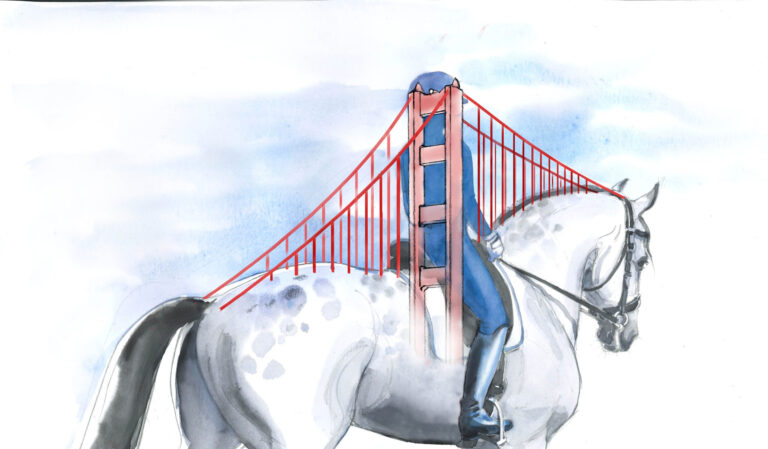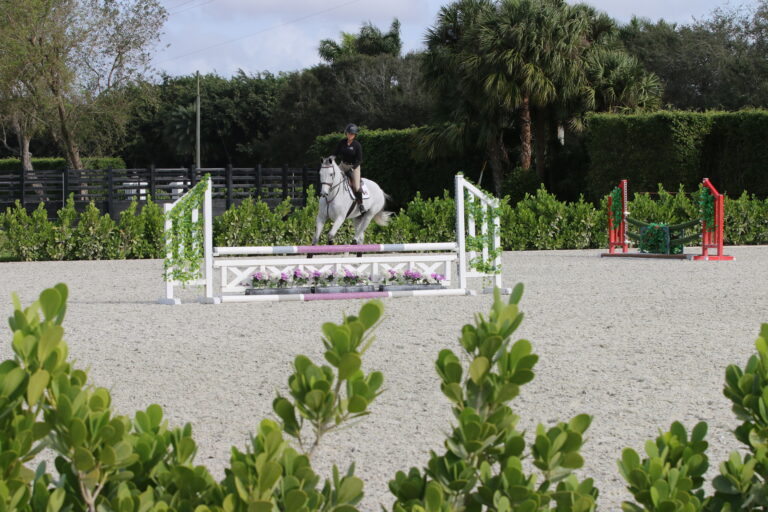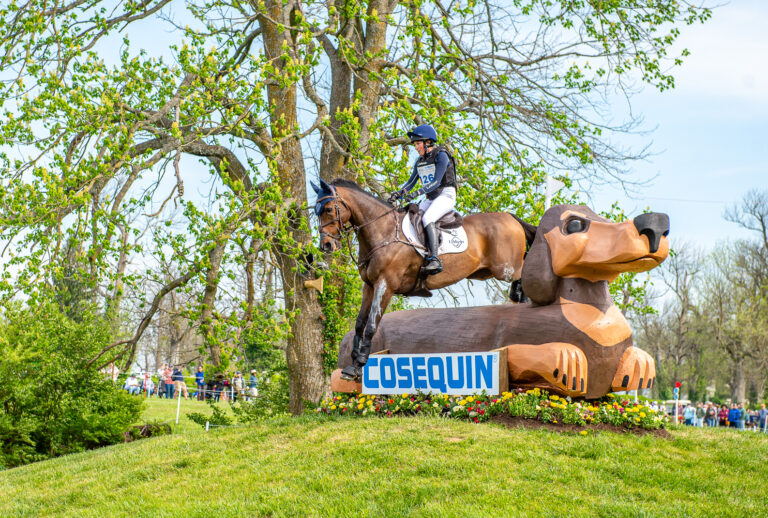Question:
I need help getting a horse I ride to be more responsive to the leg on the flat. He’s very dull on the flat but perks up and puts more effort into jumping. I’m an equitation rider, so I can’t be constantly asking him to go forward during flat classes/phases, but whenever I take my leg off the slightest bit, he makes a downward transition. I have a very strong leg from riding multiple horses a day and at least 10 minutes of no irons on each. I’ve tried bigger spurs, less bit, leg-yield, transitions, serpentines, etc. Do you have any other suggestions?

Answer:
I’m glad to hear that you’re determined to address this problem of why your horse is not responsive to the leg. Good equitation means that you ride with the most optimal position and aids for producing a horse’s best performance. This means he’s moving willingly forward and swinging his back in a way that creates suspension in his steps. You should not feel that you’re working harder than he is. The good news is that it’s generally easier to teach a slow horse to go forward than to teach a quick horse to slow down. Different horses ignore the leg aids for different reasons. So you’ll need to experiment some to find the right solution for this particular horse.
Some horses get nervous or sullen in response to the leg because they’re being forced into a frame. Others become resistant because they’re being ridden front to back rather than back to front. Front to back means riding with too much focus on the reins and front end. Conversely, you aren’t creating energy in the hind end, the engine. Your leg aids may be too strong for this horse. Consequently, this is his way of telling you to back off. Or maybe other riders abused the basic forms of communication—legs, spurs, whip. They used them too much or at the wrong times, so he’s learned to ignore them as a self-defense mechanism.
Determine Why He’s Not Responsive to Your Leg
To figure out why he’s not responding to your aids, see if he changes when you change. It’s easy to get into the habit of nagging a slow horse with your legs. This makes him even duller to them. Instead, teach yourself to try any aid or new technique only once or twice. If it doesn’t work the third time, do something different. Whatever you do, always try to work with your horse, instead of against him.
Here are three tools I’ve found very effective in cases like this:
1. Change the Scenery
Some horses need to go outside the arena to get the idea of going forward. If you have access to a large field, ride around it in your two-point. Work gradually from walk to trot to canter. Go on a trail ride with a friend on a forward-thinking horse. Even if you don’t have much open space, simply walk your horse around the barnyard. This may make him happier about responding to you.
2. Try Riding with No Contact
Let your reins get so long that you aren’t controlling his head and neck at all. Concentrate on riding his hind legs, feeling each step and using your leg aids in rhythm with the movement. Good communication is more about timing than strength. The more in tune you get with the horse’s rhythm, the better your leg timing will become.
Begin at the walk on a loose rein. Then ask him to trot, adding a cluck and tap with the stick if necessary. If he begins to move more freely forward, he’s telling you that the contact was too heavy before. Instead of picking it back up right away, try riding with the illusion of contact. Communicate with almost no pressure in the reins. When he’s going well, pick up the contact in the outside rein. Still keep the inside rein as soft as possible. Always hold the reins thinking about where the corners of his mouth are, without trying to force the flexion.
3. Try “Cowboy Rope Energy”
Snap a cotton lead shank to your belt loop and hold it in one hand while you ride. When your horse doesn’t respond promptly to your leg aid, swing the end of the rope in the air to the side without hitting him with it. Be very careful doing this at first! Check that you’re sitting firmly in the saddle with your heels down and your reins loose. You don’t want to risk pulling on them if he lurches forward suddenly. (I only recommend this tool for experienced, secure riders because some horses initially react unpredictably to it.)
Most horses will move forward and away from the rope. If you hold it in your left hand, your horse will move right, and vice versa. So it helps to address one-sidedness as well. With practice, you’ll learn how to swing it in a way that makes a little whistling sound. I’ve found that many horses who ignore whips and spurs respond positively to this rope energy.
If this works for you, too, continue carrying the rope to reinforce your aids. Do this until he moves forward reliably in response to normal leg pressure.
Remember, we’re all creatures of habit. If something isn’t working in your ring, make a change. Learning to adapt your style to get he best out of every horse will make you a better rider, too!
About Anne Kenan
Hunter trainer, clinician and judge Anne Kenan has worked in the horse industry for more than 40 years. As a partner in Hunter Hill Farm, Inc., she co-hosted various shows. These included both local and A-rated shows in the Atlanta, Georgia, area for a decade. She has also bred, raised and trained national champion show hunters and taught young riding stars. These include Olympic show jumper Laura Kraut and leading hunter rider Holly Orlando. A USEF “R” judge for 18 years, Anne has expanded her equestrian services to include consulting.
This article originally appeared in the March 2013 issue of Practical Horseman.











